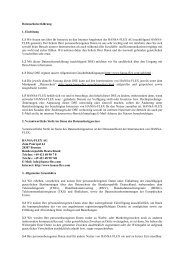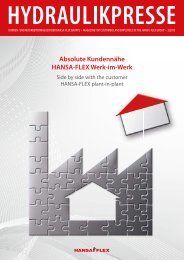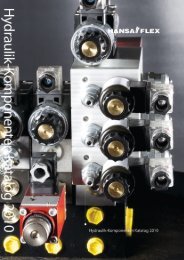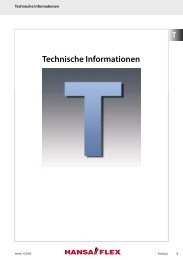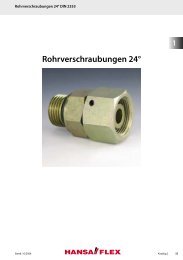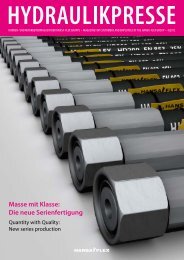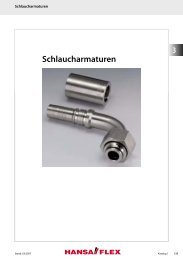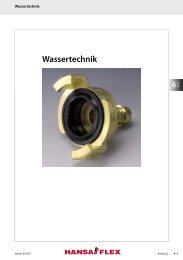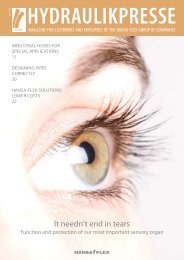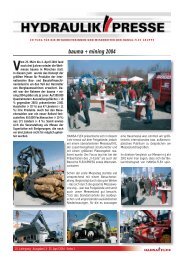HYDRAULIKPRESSE 2/2013 - einseitig - Hansa Flex
HYDRAULIKPRESSE 2/2013 - einseitig - Hansa Flex
HYDRAULIKPRESSE 2/2013 - einseitig - Hansa Flex
Sie wollen auch ein ePaper? Erhöhen Sie die Reichweite Ihrer Titel.
YUMPU macht aus Druck-PDFs automatisch weboptimierte ePaper, die Google liebt.
DID yoU know...? scHOn GeWussT...?<br />
schon vor über 10.000 Jahren wurde Bernstein zu schmuck<br />
verarbeitet.<br />
amber was being worked for ornamental purposes as much<br />
as 10,000 years ago.<br />
worked to form items of adornment at a very early<br />
stage. So archaeologists regularly find amber beads<br />
and other items of jewellery in treasure caches or<br />
among burial objects. and these finds are not by<br />
any means limited to a given geographical region.<br />
For example, a necklace consisting of about 3,000<br />
amber beads was recovered in the excavation of a<br />
3,000-year-old urn grave close to Ingolstadt. Such<br />
an item must have been of practically incalculable<br />
value in its time. at digs in southern england, archaeologists<br />
found two gold rings, each of which<br />
was inlaid with a sliver of amber. But the remarkable<br />
thing about the find was this: an almost identical<br />
artefact was found in Mycenae, which was an<br />
important commercial centre in the Bronze age<br />
(about 1500 years before the Common era). and<br />
amber jewellery dating from more than 6,000 years<br />
ago has even been found in egypt.<br />
early GlOBalisaTiOn<br />
Scientific analyses of the amber artefacts found<br />
in egypt have revealed that the amber originated<br />
from the southeastern region of the Baltic Sea<br />
coast. then, as now, the Baltic region was a major<br />
source of amber – particularly the Samland Peninsula<br />
in the former east Prussia, which is now part<br />
of russia in the kaliningrad region. archaeologists<br />
are therefore puzzled as to how amber jewellery<br />
might have travelled all the way to north africa in<br />
such early times. there can only be one explanation:<br />
trade in amber must have been flourishing<br />
3,000 years ago. In a documentary entitled “Die<br />
Bernsteinstraße” (the amber route) broadcast by<br />
the arte television station in the summer of 2012,<br />
archaeologist Dr timo Ibsen followed one of the<br />
possible trade routes from thebes to the Baltic region.<br />
In the programme, the archaeologist’s route<br />
is compared with a virtual journey to the Baltic Sea<br />
coast undertaken by an egyptian 1,400 years ago.<br />
the first stop on the journey is the archaeological<br />
site at Qatna in Syria, where a well-preserved<br />
amber lion was excavated. the route taken by timo<br />
Ibsen then passes through the city of Uluburun<br />
in southern turkey, where a large number of amber<br />
beads were discovered in a sunken trading<br />
ship, and on to Mycenae. Significant amber finds<br />
have been reported here, too. the route continues<br />
through the Brenner Pass in the alps, whose very<br />
name may quite possibly be derived from the old<br />
German word for amber, Brennstein. other stations<br />
on this possible trade route include the ancient settlement<br />
of Bernstorf near Freising in Bavaria, which<br />
according to ancient legend enjoyed vast wealth,<br />
Ingolstadt, nebra, where the famed sky disc was<br />
discovered, and neustrelitz. whether amber was really<br />
traded between the Baltic Sea and north africa<br />
in this way is still open to question. But it is beyond<br />
dispute that such trade routes did exist.<br />
FascinaTinG prOperTies<br />
But why are people so enthralled by amber? one of<br />
the reasons may be that it can be worked very easily,<br />
and has a unique appearance. But it owes its appeal<br />
mostly to its extraordinary properties. amber<br />
floats in salt water and can be charged electrically<br />
by rubbing. Its most remarkable feature, though, is<br />
the fact that amber burns readily, which is why it is<br />
called burning stone. when exposed to a flame, it<br />
gives off a resinous fragrance. So it was often used<br />
for ritual purposes, and even today it is used as a<br />
substitute for incense in India. today, the largest<br />
amber mining site in the world is near the town of<br />
Jantarny, not far from kaliningrad. In 2008, about<br />
500 tons of amber were extracted, 90 percent of<br />
which is used for manufacturing varnish. although<br />
in our times it is used almost exclusively for a very<br />
mundane purpose, amber has still lost nothing of its<br />
fascination. •<br />
<strong>HYDRAULIKPRESSE</strong> 2|<strong>2013</strong><br />
49



